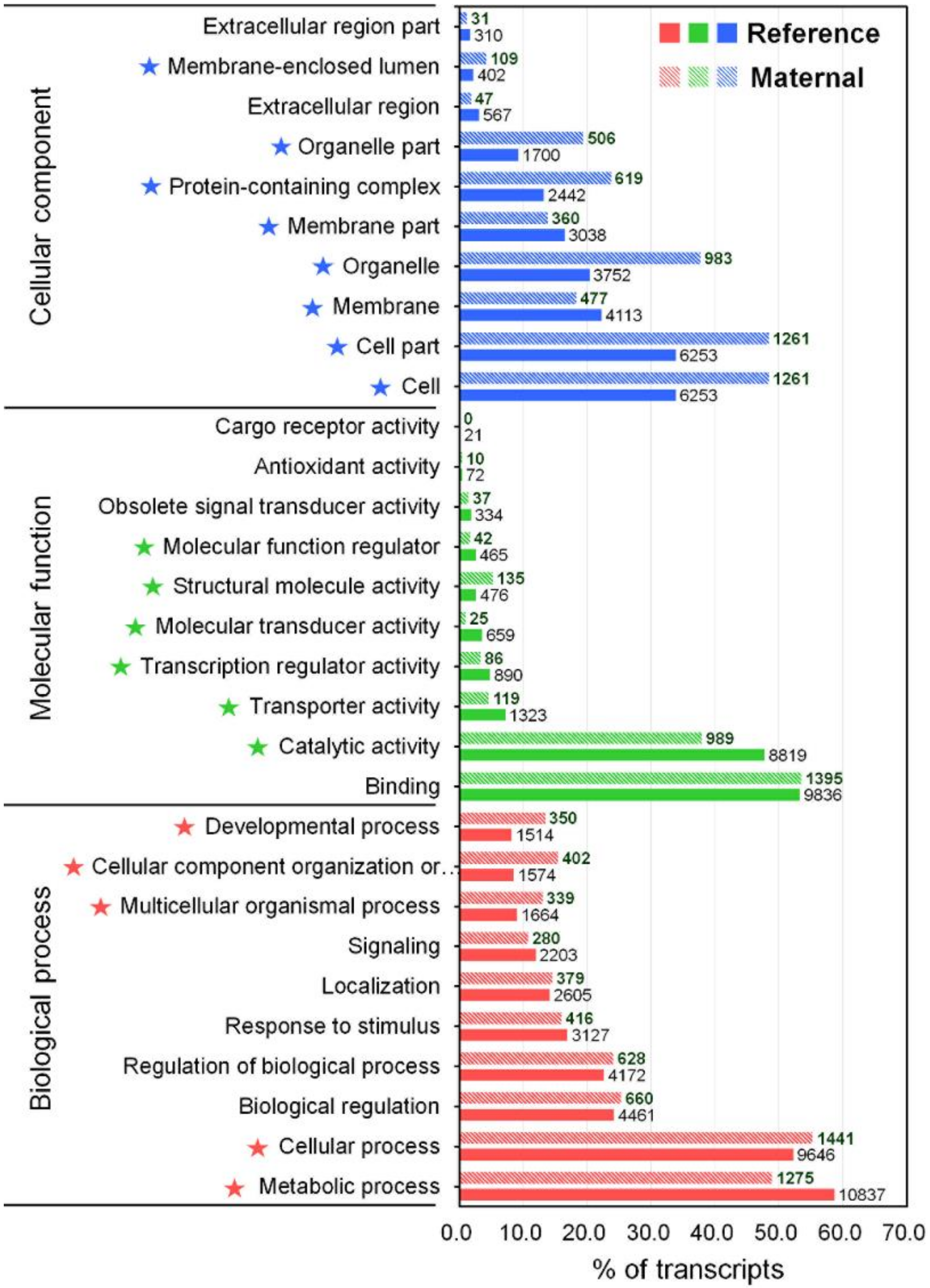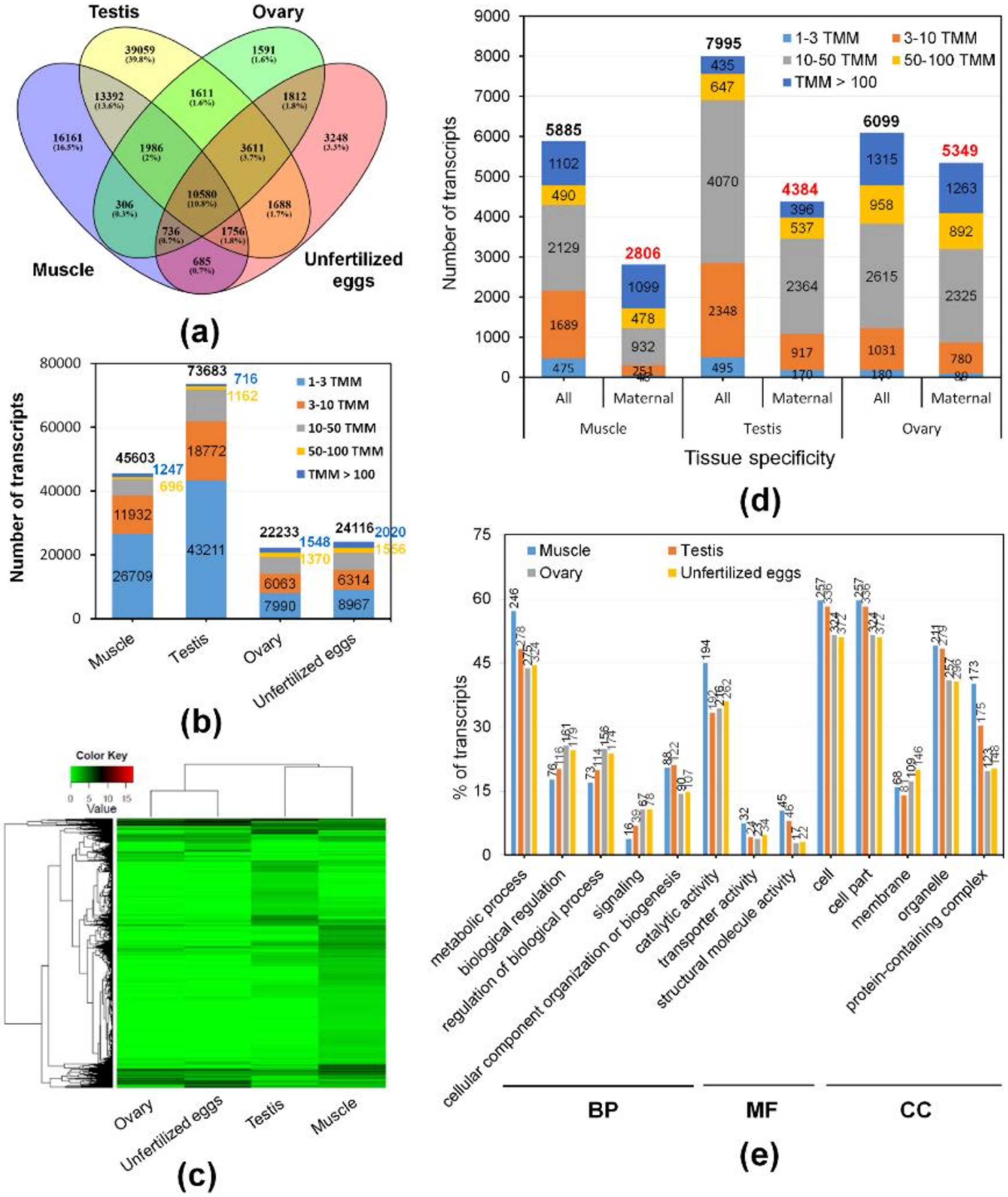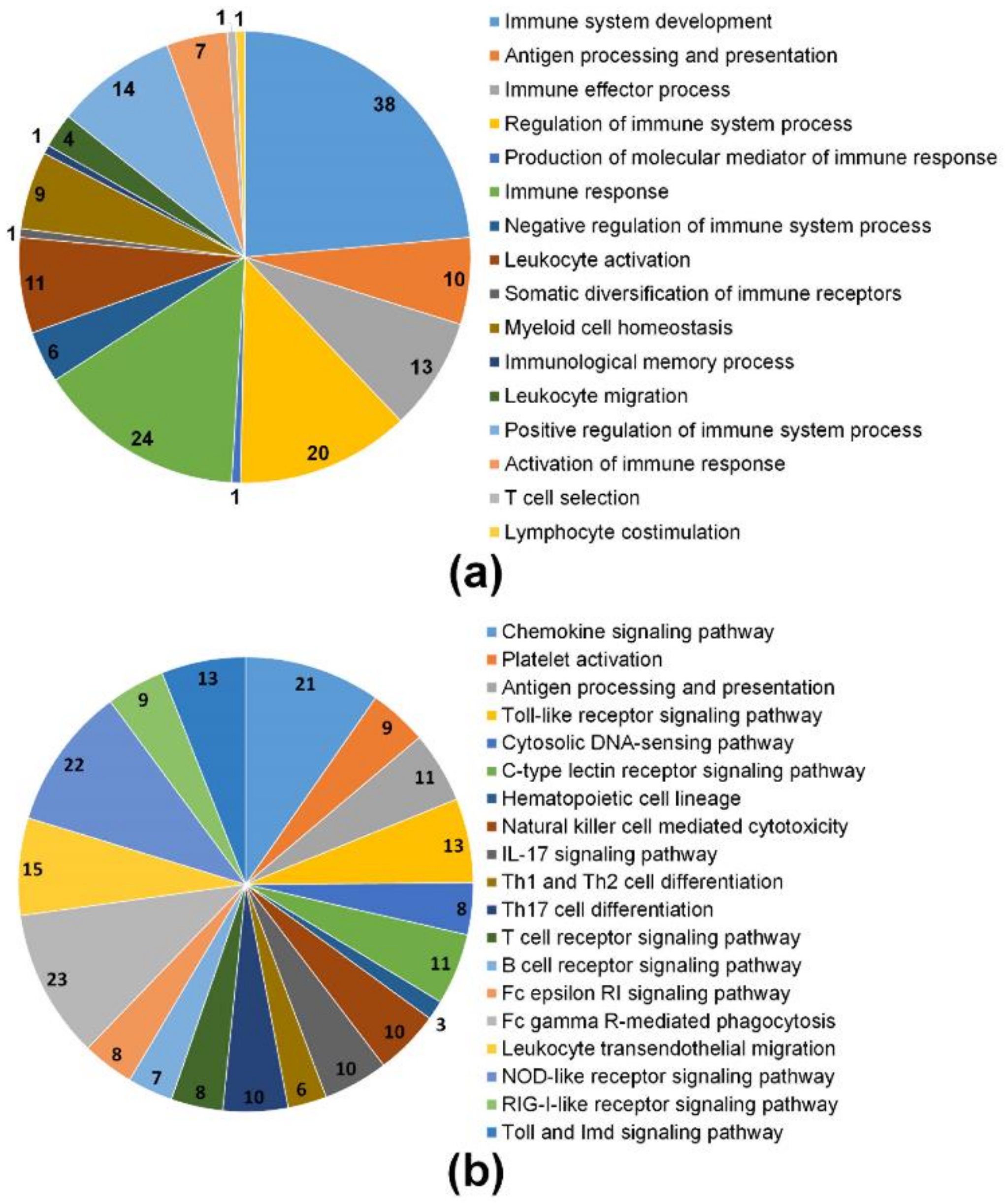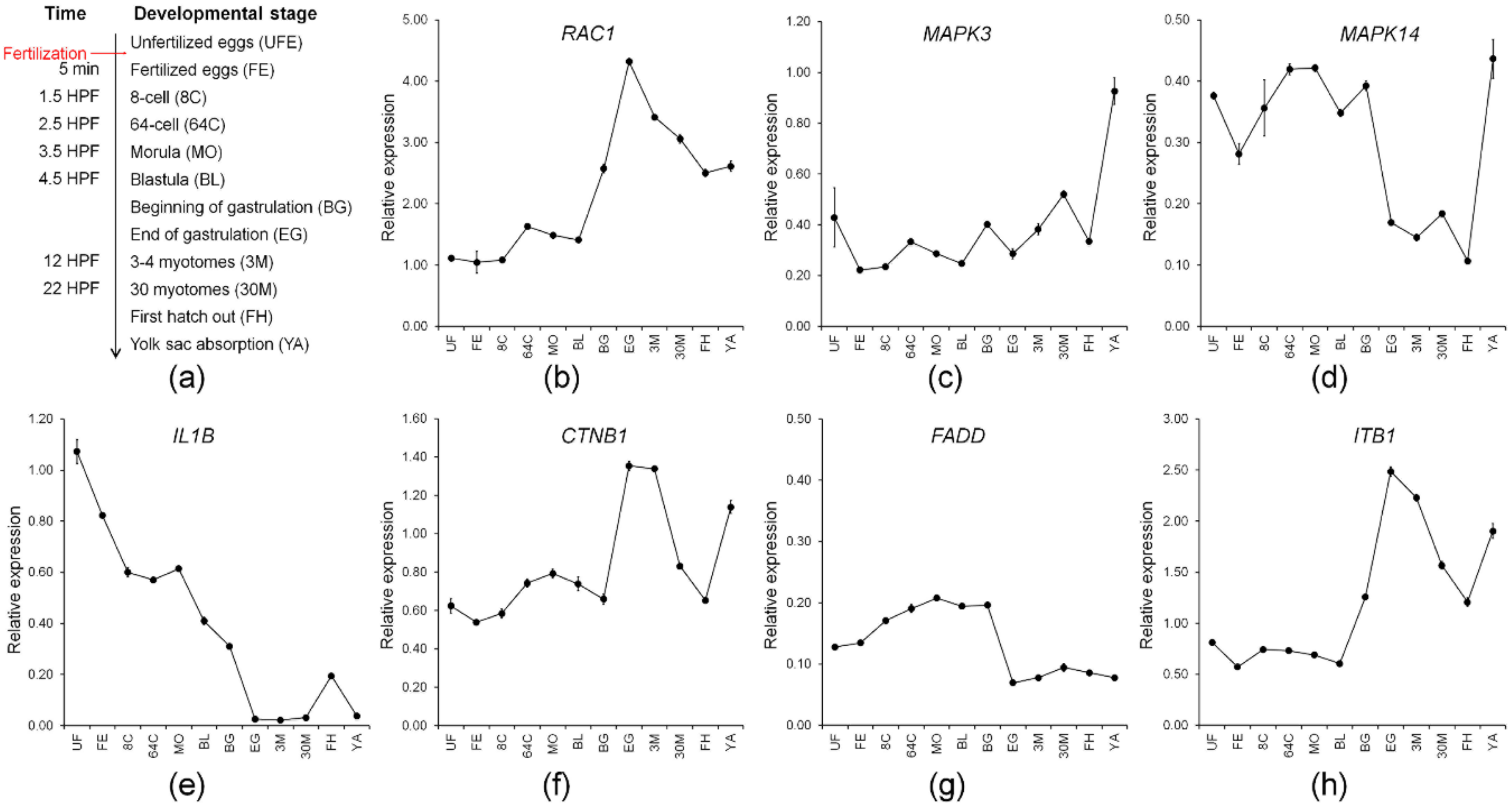Transcriptome Analysis of Maternal Gene Transcripts in Unfertilized Eggs of Misgurnus anguillicaudatus and Identification of Immune-Related Maternal Genes
Abstract
1. Introduction
2. Results and Discussion
2.1. Sequencing, De Novo Assembly, and Completeness
2.2. Functional Annotation of the Reference Transcriptome
2.3. Expression Analysis and Characterization of Maternal Transcripts
2.4. Identification of Maternal Gene Transcripts Related to Immune Functions
2.5. Transcriptional Levels of Maternal Immune-Related Candidate Genes during Development and Early Ontogeny of M. anguillicaudatus
2.6. Data Availability
3. Materials and Methods
3.1. Fish Rearing and Sample Collection
3.2. RNA Isolation, Library Construction, and Sequencing
3.3. De Novo Assembly and Completeness of Transcriptome
3.4. Functional Annotation
3.5. Expression Analysis and Specificity Classification
3.6. qPCR Analysis and Measurement of Transcriptional Levels of Identified Candidate Genes during Ontogeny of M. anguillicaudatus
4. Conclusions
Supplementary Materials
Author Contributions
Funding
Conflicts of Interest
Abbreviations
| RIN | RNA integrity number |
| BUSCO | Benchmarking Universal Single-Copy Orthologs |
| KEGG | Kyoto Encyclopedia of Genes and Genomes |
| GO | Gene ontology |
| TMM | Trimmed mean normalization of M-values |
References
- Bowerman, B. Maternal control of pattern formation in early Caenorhabditis elegans embryos. Curr. Top. Dev. Biol. 1998, 39, 73–117. [Google Scholar] [PubMed]
- Pelegri, F. Maternal factors in zebrafish development. Dev. Dynamics Off Pub. Am. Assoc. Anatomists 2003, 228, 535–554. [Google Scholar] [CrossRef] [PubMed]
- Minami, N.; Suzuki, T.; Tsukamoto, S. Zygotic gene activation and maternal factors in mammals. J. Reprod. Dev. 2007, 53, 707–715. [Google Scholar] [CrossRef] [PubMed]
- White, J.A.; Heasman, J. Maternal control of pattern formation in Xenopus laevis. J. Exp. Zool. Part. B Mol. Dev. Evol. 2008, 310, 73–84. [Google Scholar] [CrossRef] [PubMed]
- Swain, P.; Nayak, S.K. Role of maternally derived immunity in fish. Fish. Shellfish Immunol. 2009, 27, 89–99. [Google Scholar] [CrossRef]
- Lyman-Gingerich, J.; Pelegri, F. Maternal factors in fish oogenesis and embryonic development. In The Fish Oocyte; Springer: Berlin/Heidelberg, Germany, 2007. [Google Scholar]
- Abrams, E.W.; Mullins, M.C. Early zebrafish development: It’s in the maternal genes. Curr. Opin. Genet. Dev. 2009, 19, 396–403. [Google Scholar] [CrossRef]
- Brooks, S.; Tyler, C.R.; Sumpter, J.P. Egg quality in fish: What makes a good egg? Rev. Fish. Biol. Fish. 1997, 7, 387–416. [Google Scholar] [CrossRef]
- Bobe, J.; Labbé, C. Egg and sperm quality in fish. Gen. Comp. Endocrinol. 2010, 165, 535–548. [Google Scholar] [CrossRef]
- Mommens, M.; Fernandes, J.M.O.; Bizuayehu, T.T.; Bolla, S.L.; Johnston, I.A.; Babiak, I. Maternal gene expression in Atlantic halibut (Hippoglossus hippoglossus L.) and its relation to egg quality. BMC Res. Notes 2010, 3, 138. [Google Scholar] [CrossRef]
- Sullivan, C.V.; Chapman, R.W.; Reading, B.J.; Anderson, P.E. Transcriptomics of mRNA and egg quality in farmed fish: Some recent developments and future directions. Gen. Comp. Endocrinol. 2015, 221, 23–30. [Google Scholar] [CrossRef]
- Wargelius, A.; Furmanek, T.; Montfort, J.; Le Cam, A.; Kleppe, L.; Juanchich, A.; Edvardsen, R.B.; Taranger, G.L.; Bobe, J. A comparison between egg trancriptomes of cod and salmon reveals species-specific traits in eggs for each species. Mol. Reprod. Dev. 2015, 82, 397–404. [Google Scholar] [CrossRef]
- Subramanian, N.; Torabi-Parizi, P.; Gottschalk, R.A.; Germain, R.N.; Dutta, B. Network representations of immune system complexity. Wiley Interdiscip. Rev. Syst. Biol. Med. 2015, 7, 13–38. [Google Scholar] [CrossRef] [PubMed]
- Rauta, P.R.; Nayak, B.; Das, S. Immune system and immune responses in fish and their role in comparative immunity study: A model for higher organisms. Immunol. Lett. 2012, 148, 23–33. [Google Scholar] [PubMed]
- Akira, S.; Takeda, K. Toll-like receptor signalling. Nat. Rev. Immunol. 2004, 4, 499–511. [Google Scholar] [CrossRef] [PubMed]
- Nüsslein-Volhard, C.; Wieschaus, E. Mutations affecting segment number and polarity in Drosophila. Nature 1980, 287, 795–801. [Google Scholar] [CrossRef] [PubMed]
- Mulero, I.; García-Ayala, A.; Meseguer, J.; Mulero, V. Maternal transfer of immunity and ontogeny of autologous immunocompetence of fish: A minireview. Aquaculture 2007, 268, 244–250. [Google Scholar]
- Zhang, S.; Wang, Z.; Wang, H. Maternal immunity in fish. Dev. Comp. Immunol. 2013, 39, 72–78. [Google Scholar]
- Harvey, S.A.; Sealy, I.; Kettleborough, R.; Fenyes, F.; White, R.; Stemple, D.; Smith, J.C. Identification of the zebrafish maternal and paternal transcriptomes. Development 2013, 140, 2703–2710. [Google Scholar] [CrossRef]
- Rauwerda, H.; Wackers, P.; Pagano, J.F.B.; de Jong, M.; Ensink, W.; Dekker, R.; Nehrdich, U.; Spaink, H.P.; Jonker, M.; Breit, T.M. Mother-specific signature in the maternal transcriptome composition of mature, unfertilized zebrafish eggs. PLoS ONE 2016, 11, e0147151. [Google Scholar] [CrossRef]
- Zhou, H.; Xu, Q.-Z.; Zhang, R.; Zhuang, Z.-X.; Ma, Y.-Q.; Wang, W.; Ma, T.-Y.; Sui, Y.; Liu, Y.; Cao, X. Gonadal transcriptome analysis of hybrid triploid loaches (Misgurnus anguillicaudatus) and their diploid and tetraploid parents. PLoS ONE 2018, 13, e0198179. [Google Scholar]
- Lanes, C.F.C.; Bizuayehu, T.T.; de Oliveira Fernandes, J.M.; Kiron, V.; Babiak, I. Transcriptome of Atlantic cod (Gadus morhua L.) early embryos from farmed and wild broodstocks. Mar. Biotechnol. 2013, 15, 677–694. [Google Scholar] [PubMed]
- Kleppe, L.; Edvardsen, R.B.; Furmanek, T.; Taranger, G.L.; Wargelius, A. Global transcriptome analysis identifies regulated transcripts and pathways activated during oogenesis and early embryogenesis in Atlantic cod. Mol. Reprod. Dev. 2014, 81, 619–635. [Google Scholar]
- Rauwerda, H.; Pagano, J.F.B.; de Leeuw, W.C.; Ensink, W.; Nehrdich, U.; de Jong, M.; Jonker, M.; Spaink, H.P.; Breit, T.M. Transcriptome dynamics in early zebrafish embryogenesis determined by high-resolution time course analysis of 180 successive, individual zebrafish embryos. BMC Genom. 2017, 18, 287. [Google Scholar]
- Romney, A.L.; Podrabsky, J.E. Transcriptomic analysis of maternally provisioned cues for phenotypic plasticity in the annual killifish, Austrofundulus limnaeus. EvoDevo 2017, 8, 6. [Google Scholar] [CrossRef] [PubMed]
- Kim, D.S.; Nam, Y.K.; Park, I.-S. Survival and karyological analysis of reciprocal diploid and triploid hybrids between mud loach (Misgurnus mizolepis) and cyprinid loach (Misgurnus anguillicaudatus). Aquaculture 1995, 135, 257–265. [Google Scholar]
- Nam, Y.K.; Park, I.-S.; Kim, D.S. Triploid hybridization of fast-growing transgenic mud loach Misgurnus mizolepis male to cyprinid loach Misgurnus anguillicaudatus female: The first performance study on growth and reproduction of transgenic polyploid hybrid fish. Aquaculture 2004, 231, 559–572. [Google Scholar] [CrossRef]
- Fujimoto, T.; Kataoka, T.; Sakao, S.; Saito, T.; Yamaha, E.; Arai, K. Developmental stages and germ cell lineage of the loach (Misgurnus anguillicaudatus). Zool. Sci. 2006, 23, 977–989. [Google Scholar] [CrossRef] [PubMed]
- Arai, K.; Fujimoto, T. Genomic constitution and atypical reproduction in polyploid and unisexual lineages of the Misgurnus loach, a teleost fish. Cytogenet. Genome Res. 2013, 140, 226–240. [Google Scholar] [CrossRef]
- Bolger, A.M.; Lohse, M.; Usadel, B. Trimmomatic: A flexible trimmer for Illumina sequence data. Bioinformatics 2014, 30, 2114–2120. [Google Scholar]
- Grabherr, M.G.; Haas, B.J.; Yassour, M.; Levin, J.Z.; Thompson, D.A.; Amit, I.; Adiconis, X.; Fan, L.; Raychowdhury, R.; Zeng, Q. Full-length transcriptome assembly from RNA-Seq data without a reference genome. Nat. Biotechnol. 2011, 29, 644. [Google Scholar] [CrossRef]
- Li, W.; Godzik, A. Cd-hit: A fast program for clustering and comparing large sets of protein or nucleotide sequences. Bioinformatics 2006, 22, 1658–1659. [Google Scholar] [PubMed]
- Schliesky, S.; Gowik, U.; Weber, A.P.M.; Bräutigam, A. RNA-Seq assembly—Are we there yet? Front. Plant. Sci. 2012, 3, 220. [Google Scholar] [PubMed]
- Kumar, S.; Blaxter, M.L. Comparing de novo assemblers for 454 transcriptome data. BMC Genom. 2010, 11, 571. [Google Scholar]
- Luo, W.; Cao, X.; Xu, X.; Huang, S.; Liu, C.; Tomljanovic, T. Developmental transcriptome analysis and identification of genes involved in formation of intestinal air-breathing function of Dojo loach, Misgurnus anguillicaudatus. Sci. Rep. 2016, 6, 31845. [Google Scholar] [PubMed]
- Luo, W.; Liu, C.; Cao, X.; Huang, S.; Wang, W.; Wang, Y. Transcriptome profile analysis of ovarian tissues from diploid and tetraploid loaches Misgurnus anguillicaudatus. Int. J. Mol. Sci. 2015, 16, 16017–16033. [Google Scholar] [PubMed]
- Long, Y.; Li, Q.; Zhou, B.; Song, G.; Li, T.; Cui, Z. De novo assembly of mud loach (Misgurnus anguillicaudatus) skin transcriptome to identify putative genes involved in immunity and epidermal mucus secretion. PLoS ONE 2013, 8, e56998. [Google Scholar] [CrossRef]
- Waterhouse, R.M.; Seppey, M.; Simão, F.A.; Manni, M.; Ioannidis, P.; Klioutchnikov, G.; Kriventseva, E.V.; Zdobnov, E.M. BUSCO applications from quality assessments to gene prediction and phylogenomics. Mol. Biol. Evol. 2018, 35, 543–548. [Google Scholar] [CrossRef]
- Simão, F.A.; Waterhouse, R.M.; Ioannidis, P.; Kriventseva, E.V.; Zdobnov, E.M. BUSCO: Assessing genome assembly and annotation completeness with single-copy orthologs. Bioinformatics 2015, 31, 3210–3212. [Google Scholar]
- Ashburner, M.; Ball, C.A.; Blake, J.A.; Botstein, D.; Butler, H.; Cherry, J.M.; Davis, A.P.; Dolinski, K.; Dwight, S.S.; Eppig, J.T. Gene Ontology: Tool for the unification of biology. Nat. Genet. 2000, 25, 25. [Google Scholar] [CrossRef] [PubMed]
- Conesa, A.; Götz, S.; García-Gómez, J.M.; Terol, J.; Talón, M.; Robles, M. Blast2GO: A universal tool for annotation, visualization and analysis in functional genomics research. Bioinformatics 2005, 21, 3674–3676. [Google Scholar]
- Ye, J.; Fang, L.; Zheng, H.; Zhang, Y.; Chen, J.; Zhang, Z.; Wang, J.; Li, S.; Li, R.; Bolund, L. WEGO: A web tool for plotting GO annotations. Nucleic Acids Res. 2006, 34 (Suppl. 2), W293–W297. [Google Scholar] [CrossRef] [PubMed]
- Zhang, Y.; Li, Y.; Liang, X.; Cao, X.; Huang, L.; Yan, J.; Wei, Y.; Gao, J. Hepatic transcriptome analysis and identification of differentially expressed genes response to dietary oxidized fish oil in loach Misgurnus anguillicaudatus. PLoS ONE 2017, 12, e0172386. [Google Scholar] [CrossRef]
- Moriya, Y.; Itoh, M.; Okuda, S.; Yoshizawa, A.C.; Kanehisa, M. KAAS: An automatic genome annotation and pathway reconstruction server. Nucleic Acids Res. 2007, 35 (Suppl. 2), W182–W185. [Google Scholar] [CrossRef] [PubMed]
- Kanehisa, M.; Goto, S.; Sato, Y.; Kawashima, M.; Furumichi, M.; Tanabe, M. Data, information, knowledge and principle: Back to metabolism in KEGG. Nucleic Acids Res. 2014, 42, D199–D205. [Google Scholar] [CrossRef] [PubMed]
- Schier, A.F. The maternal-zygotic transition: Death and birth of RNAs. Science 2007, 316, 406–407. [Google Scholar] [CrossRef] [PubMed]
- Lubzens, E.; Bobe, J.; Young, G.; Sullivan, C.V. Maternal investment in fish oocytes and eggs: The molecular cargo and its contributions to fertility and early development. Aquaculture 2017, 472, 107–143. [Google Scholar] [CrossRef]
- Picchietti, S.; Taddei, A.R.; Scapigliati, G.; Buonocore, F.; Fausto, A.M.; Romano, N.; Mazzini, M.; Mastrolia, L.; Abelli, L. Immunoglobulin protein and gene transcripts in ovarian follicles throughout oogenesis in the teleost Dicentrarchus labrax. Cell Tissue Res. 2004, 315, 259–270. [Google Scholar] [CrossRef]
- Knoll-Gellida, A.; André, M.; Gattegno, T.; Forgue, J.; Admon, A.; Babin, P.J. Molecular phenotype of zebrafish ovarian follicle by serial analysis of gene expression and proteomic profiling, and comparison with the transcriptomes of other animals. BMC Genom. 2006, 7, 46. [Google Scholar] [CrossRef]
- Knoll-Gellida, A.; Babin, P.J. Zebrafish ovarian follicle transcriptome. In The Fish Oocyte; Springer: Berlin/Heidelberg, Germany, 2007. [Google Scholar]
- He, X.; Zhang, J. Toward a molecular understanding of pleiotropy. Genetics 2006, 173, 1885–1891. [Google Scholar] [CrossRef]
- Dudley, A.M.; Janse, D.M.; Tanay, A.; Shamir, R.; Church, G.M. A global view of pleiotropy and phenotypically derived gene function in yeast. Mol. Syst. Biol. 2005, 1. [Google Scholar] [CrossRef]
- Preuss, K.M.; Lopez, J.A.; Colbourne, J.K.; Wade, M.J. Identification of maternally-loaded RNA transcripts in unfertilized eggs of Tribolium castaneum. BMC Genom. 2012, 13, 671. [Google Scholar] [CrossRef]
- Zou, L.; Sriswasdi, S.; Ross, B.; Missiuro, P.V.; Liu, J.; Ge, H. Systematic analysis of pleiotropy in C. elegans early embryogenesis. PLoS Comput. Biol. 2008, 4, e1000003. [Google Scholar]
- Sonawane, A.R.; Platig, J.; Fagny, M.; Chen, C.-Y.; Paulson, J.N.; Lopes-Ramos, C.M.; DeMeo, D.L.; Quackenbush, J.; Glass, K.; Kuijjer, M.L. Understanding tissue-specific gene regulation. Cell Rep. 2017, 21, 1077–1088. [Google Scholar] [CrossRef]
- Watanabe, K.; Stringer, S.; Frei, O.; Mirkov, M.U.; de Leeuw, C.; Polderman, T.J.C.; van der Sluis, S.; Andreassen, O.A.; Neale, B.M.; Posthuma, D. A global overview of pleiotropy and genetic architecture in complex traits. Nat. Genet. 2019, 51, 1339–1348. [Google Scholar] [CrossRef] [PubMed]
- Jain, A.; Tuteja, G. TissueEnrich: Tissue-specific gene enrichment analysis. Bioinformatics 2018, 35, 1966–1967. [Google Scholar]
- Giraldez, A.J.; Mishima, Y.; Rihel, J.; Grocock, R.J.; Van Dongen, S.; Inoue, K.; Enright, A.J.; Schier, A.F. Zebrafish MiR-430 promotes deadenylation and clearance of maternal mRNAs. Science 2006, 312, 75–79. [Google Scholar] [PubMed]
- Lee, J.W.; Kim, J.E.; Goo, I.B.; Hwang, J.-A.; Im, J.H.; Choi, H.-S.; Lee, J.-H. Expression of immune-related genes during loach (Misgurnus anguillicaudatus) embryonic and early larval development. Dev. Reprod. 2015, 19, 181. [Google Scholar] [CrossRef]
- Salas-Vidal, E.; Meijer, A.H.; Cheng, X.; Spaink, H.P. Genomic annotation and expression analysis of the zebrafish Rho small GTPase family during development and bacterial infection. Genomics 2005, 86, 25–37. [Google Scholar]
- Han, F.; Wang, X.; Yang, Q.; Cai, M.; Wang, Z.Y. Characterization of a RacGTPase up-regulated in the large yellow croaker Pseudosciaena crocea immunity. Fish. Shellfish Immunol. 2011, 30, 501–508. [Google Scholar] [CrossRef]
- Jia, A.; Zhang, X.-H. cDNA cloning, characterization, and expression analysis of the Rac1 gene from Scophthalmus maximus. Comp. Biochem. Physiol. Part. B Biochem. Mol. Biol. 2009, 154, 80–84. [Google Scholar]
- Lu, F.-I.; Thisse, C.; Thisse, B. Identification and mechanism of regulation of the zebrafish dorsal determinant. Proc. Natl. Acad. Sci. USA 2011, 108, 15876–15880. [Google Scholar] [CrossRef] [PubMed]
- Zhang, M.; Zhang, J.; Lin, S.-C.; Meng, A. β-Catenin 1 and β-catenin 2 play similar and distinct roles in left-right asymmetric development of zebrafish embryos. Development 2012, 139, 2009–2019. [Google Scholar] [CrossRef] [PubMed]
- Chiou, M.-J.; Wang, Y.-D.; Kuo, C.-M.; Chen, J.-C.; Chen, J.-Y. Functional analysis of mitogen-activated protein kinase-3 (MAPK3) and its regulation of the promoter region in zebrafish. Dna Cell Biol. 2007, 26, 781–790. [Google Scholar] [CrossRef] [PubMed]
- Roufidou, C.; Feidantsis, K.; Mente, E.; Sarropoulou, E.; Antonopoulou, E. Heat shock protein (HSP) expression and mitogen-activated protein kinase (MAPK) phosphorylation during early embryonic developmental stages of the Gilthead sea bream (Sparus aurata). Mediterr. Mar. Sci. 2018, 19, 240–247. [Google Scholar]
- Umasuthan, N.; Bathige, S.D.N.K.; Noh, J.K.; Lee, J. Gene structure, molecular characterization and transcriptional expression of two p38 isoforms (MAPK11 and MAPK14) from rock bream (Oplegnathus fasciatus). Fish. Shellfish Immunol. 2015, 47, 331–343. [Google Scholar]
- Hong, S.; Zou, J.; Collet, B.; Bols, N.C.; Secombes, C.J. Analysis and characterisation of IL-1β processing in rainbow trout, Oncorhynchus mykiss. Fish. Shellfish Immunol. 2004, 16, 453–459. [Google Scholar] [CrossRef]
- Jiang, S.; Zhang, D.; Li, J.; Liu, Z. Molecular characterization, recombinant expression and bioactivity analysis of the interleukin-1β from the yellowfin sea bream, Acanthopagrus latus (Houttuyn). Fish. Shellfish Immunol. 2008, 24, 323–336. [Google Scholar]
- Mathew, J.A.; Guo, Y.X.; Goh, K.P.; Chan, J.; Verburg-van Kemenade, B.M.L.; Kwang, J. Characterisation of a monoclonal antibody to carp IL-1β and the development of a sensitive capture ELISA. Fish. Shellfish Immunol. 2002, 13, 85–95. [Google Scholar]
- Ogryzko, N.V.; Hoggett, E.E.; Solaymani-Kohal, S.; Tazzyman, S.; Chico, T.J.A.; Renshaw, S.A.; Wilson, H.L. Zebrafish tissue injury causes upregulation of interleukin-1 and caspase-dependent amplification of the inflammatory response. Dis. Models Mech. 2014, 7, 259–264. [Google Scholar] [CrossRef]
- Cecchini, S.; Paciolla, M.; Biffali, E.; Borra, M.; Ursini, M.V.; Lioi, M.B. Ontogenetic profile of innate immune related genes and their tissue-specific expression in brown trout, Salmo trutta (Linnaeus, 1758). Fish. Shellfish Immunol. 2013, 35, 988–992. [Google Scholar] [CrossRef]
- Dash, P.; Patel, S.; Dixit, A.; Garg, L.C.; Sahoo, P.K. Four pro-inflammatory cytokines of rohu (Labeo rohita) during early developmental stages, their tissue distribution and expression by leucocytes upon in-vitro stimulation. Fish. Shellfish Immunol. 2015, 47, 913–922. [Google Scholar] [CrossRef] [PubMed]
- Sakamaki, K.; Nozaki, M.; Kominami, K.; Satou, Y. The evolutionary conservation of the core components necessary for the extrinsic apoptotic signaling pathway, in Medaka fish. BMC Genom. 2007, 8, 141. [Google Scholar] [CrossRef]
- Yeh, W.-C.; de La Pompa, J.L.; McCurrach, M.E.; Shu, H.-B.; Elia, A.J.; Shahinian, A.; Ng, M.; Wakeham, A.; Khoo, W.; Mitchell, K. FADD: Essential for embryo development and signaling from some, but not all, inducers of apoptosis. Science 1998, 279, 1954–1958. [Google Scholar] [CrossRef] [PubMed]
- Patel, R.K.; Jain, M. NGS QC Toolkit: A Toolkit for quality control of next generation sequencing data. PLoS ONE 2012, 7, e30619. [Google Scholar] [CrossRef] [PubMed]
- Cock, P.J.A.; Fields, C.J.; Goto, N.; Heuer, M.L.; Rice, P.M. The Sanger FASTQ file format for sequences with quality scores, and the Solexa/Illumina FASTQ variants. Nucleic Acids Res. 2010, 38, 1767–1771. [Google Scholar] [CrossRef]
- Devisetty, U.K.; Kennedy, K.; Sarando, P.; Merchant, N.; Lyons, E. Bringing your tools to cyverse discovery environment using docker. F1000Research 2016, 5. [Google Scholar]
- Haas, B.J.; Papanicolaou, A.; Yassour, M.; Grabherr, M.; Blood, P.D.; Bowden, J.; Couger, M.B.; Eccles, D.; Li, B.; Lieber, M.; et al. De novo transcript sequence reconstruction from RNA-seq using the Trinity platform for reference generation and analysis. Nat. Protoc. 2013, 8, 1494. [Google Scholar] [CrossRef]
- Finn, R.D.; Clements, J.; Eddy, S.R. HMMER web server: Interactive sequence similarity searching. Nucleic Acids Res. 2011, 39 (Suppl. 2), W29–W37. [Google Scholar] [CrossRef]
- Powell, S.; Szklarczyk, D.; Trachana, K.; Roth, A.; Kuhn, M.; Muller, J.; Arnold, R.; Rattei, T.; Letunic, I.; Doerks, T.; et al. eggNOG v3. 0: Orthologous groups covering 1133 organisms at 41 different taxonomic ranges. Nucleic Acids Res. 2011, 40, D284–D289. [Google Scholar] [CrossRef]
- Petersen, T.N.; Brunak, S.; von Heijne, G.; Nielsen, H. SignalP 4.0: Discriminating signal peptides from transmembrane regions. Nat. Methods 2011, 8, 785–786. [Google Scholar] [CrossRef]
- Krogh, A.; Larsson, B.; Von Heijne, G.; Sonnhammer, E.L. Predicting transmembrane protein topology with a hidden markov model: Application to complete genomes1. J. Mol. Biol. 2001, 305, 567–580. [Google Scholar] [CrossRef] [PubMed]
- Bray, N.L.; Pimentel, H.; Melsted, P.; Pachter, L. Near-optimal probabilistic RNA-seq quantification. Nat. Biotechnol. 2016, 34, 525–527. [Google Scholar] [CrossRef] [PubMed]
- Robinson, M.D.; Oshlack, A. A scaling normalization method for differential expression analysis of RNA-seq data. Genome Biol. 2010, 11, R25. [Google Scholar] [PubMed]
- MacManes, M.D. Establishing evidenced-based best practice for the de novo assembly and evaluation of transcriptomes from non-model organisms. BioRxiv 2016, 035642. [Google Scholar]
- Xia, X.; Huo, W.; Wan, R.; Xia, X.; Du, Q.; Chang, Z. Identification of housekeeping genes as references for quantitative real-time RT-PCR analysis in Misgurnus anguillicaudatus. J. Genet. 2017, 96, 895–904. [Google Scholar] [CrossRef] [PubMed]
- Livak, K.J.; Schmittgen, T.D. Analysis of relative gene expression data using real-time quantitative PCR and the 2− ΔΔCT method. Methods 2001, 25, 402–408. [Google Scholar] [CrossRef]






| Sequencing Stats (Illumina HiSeq 2500; paired-end, 2 × 101 bp) | |||||
| Sequencing | Ovary | Testis | Muscle | Unfertilized eggs | Total |
| No. of raw reads | 63,490,556 | 60,095,449 | 56,211,235 | 63,470,524 | 243,267,764 |
| No. of clean reads | 62,078,597 | 58,749,280 | 55,006,889 | 62,034,978 | 237,869,744 |
| Q20 of clean read | 100% | 100% | 100% | 100% | 100% |
| De novoAssembly Stats (Trinity v2.2.0) | |||||
| No. of total genes | No. of total transcripts | Total size (bp) | Mean size (bp) | N50 | GC (%) |
| 202,709 | 281,866 | 218,148,238 | 773.94 | 1692 | 42.96 |
| After Removing Non-Redundant sequzences (CD-HITest v4.6.1) | |||||
| No. of total genes | No. of total transcripts | Total size (bp) | Mean size (bp) | N50 | GC (%) |
| 193,289 | 267,111 | 197,693,642 | 740.12 | 1533 | 42.90 |
| Expression Profiling (Kallisto v0.43.0 and edgeR v3.8.5) | |||||
| Description | Ovary | Testis | Muscle | Unfertilized eggs | Average |
| Mapping ratio (%) | 95 | 92 | 89 | 95 | 92.8 |
| No. of TMM ≥ 1 | 22,233 | 73,683 | 45,603 | 24,116 | |
| Gene | Description | No. of Involved Immune System | TMM Value |
|---|---|---|---|
| RAC1 | Ras-related C3 botulinum toxin substrate 1 | 15 | 87.41 |
| MAPK3 | mitogen-activated protein kinase 3 | 13 | 60.25 |
| MAPK14 | mitogen-activated protein kinase 14 | 12 | 61.73 |
| IL1B | interleukin-1 beta | 7 | 216.87 |
| CTNB1 | catenin beta-1 | 5 | 138.05 |
| FADD | FAS-associated death domain protein | 5 | 65.82 |
| ITB1 | Integrin beta 1 | 2 | 166.79 |
| LEF1 | lymphoid enhancer-binding factor 1 | 2 | 61.20 |
| MELK | maternal embryonic leucine zipper kinase | 2 | 76.41 |
| PDPK1 | 3-phosphoinositide-dependent protein kinase 1 | 2 | 127.54 |
© 2020 by the authors. Licensee MDPI, Basel, Switzerland. This article is an open access article distributed under the terms and conditions of the Creative Commons Attribution (CC BY) license (http://creativecommons.org/licenses/by/4.0/).
Share and Cite
Kim, C.-H.; Kim, E.J.; Seo, C.; Nam, Y.K. Transcriptome Analysis of Maternal Gene Transcripts in Unfertilized Eggs of Misgurnus anguillicaudatus and Identification of Immune-Related Maternal Genes. Int. J. Mol. Sci. 2020, 21, 3872. https://doi.org/10.3390/ijms21113872
Kim C-H, Kim EJ, Seo C, Nam YK. Transcriptome Analysis of Maternal Gene Transcripts in Unfertilized Eggs of Misgurnus anguillicaudatus and Identification of Immune-Related Maternal Genes. International Journal of Molecular Sciences. 2020; 21(11):3872. https://doi.org/10.3390/ijms21113872
Chicago/Turabian StyleKim, Chan-Hee, Eun Jeong Kim, Chaehwa Seo, and Yoon Kwon Nam. 2020. "Transcriptome Analysis of Maternal Gene Transcripts in Unfertilized Eggs of Misgurnus anguillicaudatus and Identification of Immune-Related Maternal Genes" International Journal of Molecular Sciences 21, no. 11: 3872. https://doi.org/10.3390/ijms21113872
APA StyleKim, C.-H., Kim, E. J., Seo, C., & Nam, Y. K. (2020). Transcriptome Analysis of Maternal Gene Transcripts in Unfertilized Eggs of Misgurnus anguillicaudatus and Identification of Immune-Related Maternal Genes. International Journal of Molecular Sciences, 21(11), 3872. https://doi.org/10.3390/ijms21113872






